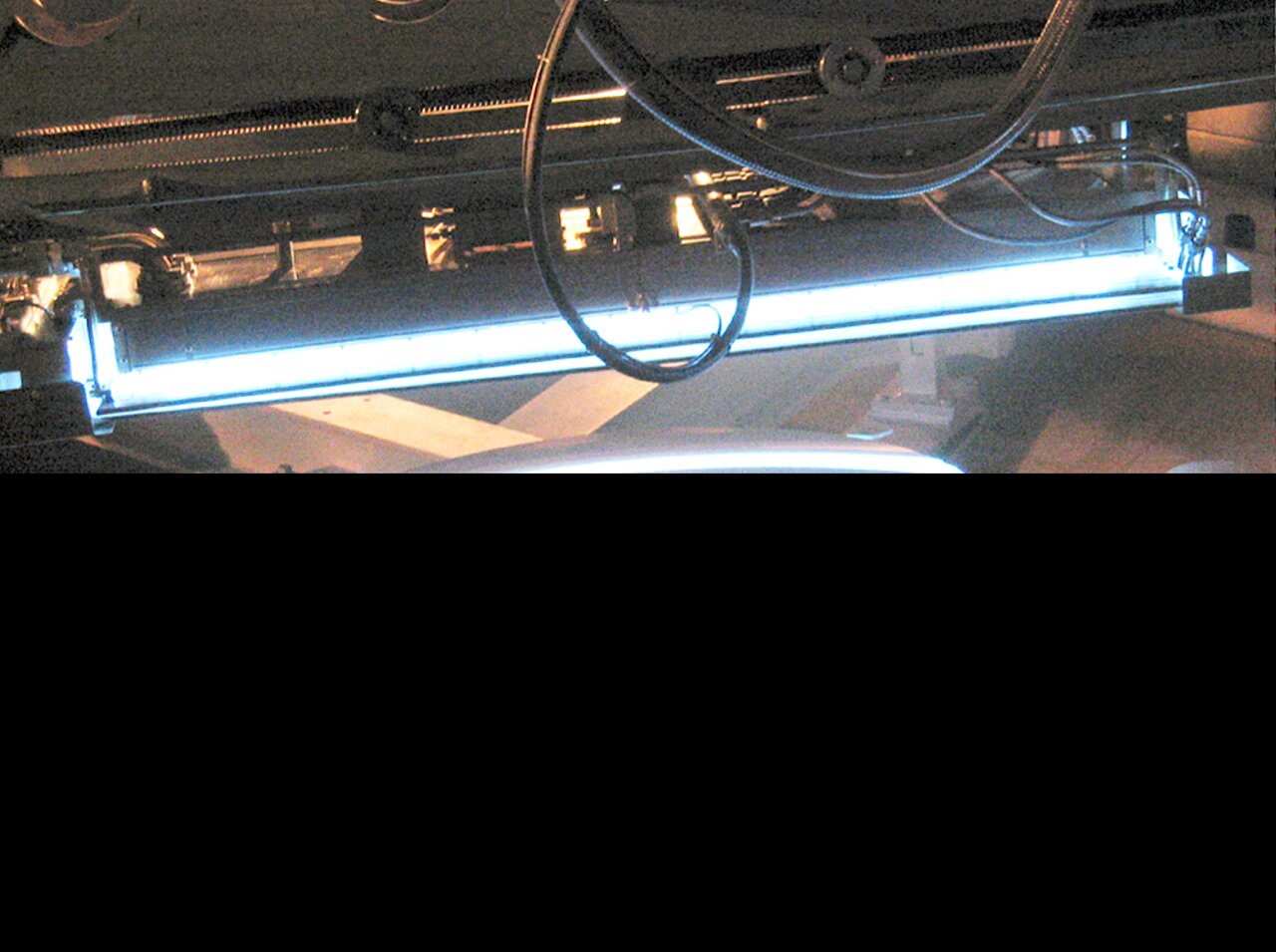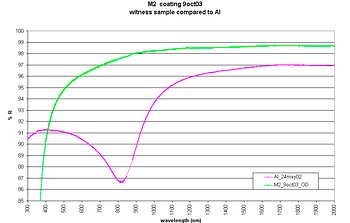Gemini South's Secondary Mirror Sports Shiny Silver Coat
October 22, 2003

The Gemini Observatory recently reached an important milestone - successful coating of the secondary mirror on Gemini South with silver. Previously, with aluminum coatings on both primary and secondary mirrors, Gemini's combined emissivity was 3.8%. Reaching this new milestone, we are increasingly confident that achieving our ambitious goal of 2% total telescope emissivity is attainable.
Reflectivity and emissivity are two measures of a mirror's performance. A highly reflective mirror is desirable in any optical telescope in order to maximize the amount of light reaching the science instrument. Ideally, a coating should reflect as close to 100% of the light that strikes it. In the thermal infrared region of the spectrum, however, a mirror coating emits a great deal of infrared radiation, and the statistical "noisiness" of this emission reduces an infrared instrument's sensitivity to emission from astronomical sources. The emissivity of an optical surface is defined as the ratio between its level of emission and that of a perfect "blackbody" emitter, and it is roughly the inverse of the reflectivity. In order to maximize infrared sensitivity, the mirror emissivity must be as low as possible. Gemini's design requirement is for emissivity not exceed 4% at 10-microns for both primary and secondary mirrors combined, with a goal of 2% at 10 microns for both mirrors.
"Low emissivity translates into higher sensitivity for the telescope," said Tom Hayward, Gemini's instrument scientist for T-ReCS, "and enhances Gemini's scientific capabilities."
Until recently, all of Gemini's mirrors were coated with aluminum, which is the material used by most telescopes (Subaru is the only other telescope in the 4-meter to 10-meter class with a silver coating on a secondary mirror, and it's bare rather than protected.) No large telescopes at present have silver-coated primary mirrors. The challenge with using silver as a coating material is that, unlike aluminum, it tarnishes with exposure to air, specifically to sulfur.
"Like the family silver set," explains Tom Geballe, Gemini Senior Astronomer, "which slowly develops brown tarnish spots over time and must be regularly polished, the shiny silver on a telescope mirror also tarnishes rapidly reducing reflectivity and increasing emissivity. The observatory's engineers, however, can't just grab a cloth and some polish when the tarnish spots appear."
Mirrors must be recoated, which does not occur more than once per year for logistical and economic reasons, so a coating has to last at least that long.
The solution to the tarnish problem is a multi-layer coating process. A three-layer process was used recently to coat Gemini's secondary mirror with silver. The first layer is an adhesive mixture of nickel and chromium spread evenly over the mirror's surface with a thickness of 50 angstroms. The second layer is the reflective layer of pure silver spread about 1000-2000 angstroms thick. The third layer is an extremely thin coating (5 angstroms or 1-2 atoms thick) of more nickel and chromium, which mildly protects the silver from tarnishing and acts as an adhesive in a four-layer coating process.
"Because the secondary mirror faces downward," explains Maxime Boccas, Opto-Mechanical Engineer for Gemini, "it's not exposed to as much dust and debris as the primary mirror, and a three-layer coating process is adequate to maintain the required reflectivity and emissivity over a one-year period." Maxime Broccas led the coating team during this complex procedure.
The primary mirror, however, requires more anti-tarnish protection than the secondary mirror. Thus, a four-step process will be necessary and will include the three layers described above plus a final layer of anti-tarnish silicon spread very thinly at 50-100 angstroms.
The three-step process applied recently to Gemini South's secondary mirror was a success: the mirror's emissivity was measured in laboratory tests to be 0.9% at 3.8 microns wavelength and is expected to be even lower near 10 microns. The Gemini facility instrument T-ReCS measured the combined emissivity of the aluminum-coated secondary and the aluminum-coated primary to be 3.8% at 9 microns. Breaking these results down, it seems likely to achieve emissivity of 0.9% for each mirror when coated with silver, or 1.8% total, which brings mirror performance in-line with Gemini's ambitious goal of 2% total emissivity. Baseline silver samples were measured during the feasibility studies and are still being used for comparison, lending greater confidence to numbers measured now.
"It is encouraging to see us making significant progress toward our goal," said Scott Fisher, Gemini Science Fellow.
Durability is equally important as performance. Gemini requires that after one year, emissivity does not increase by more than 1%. Experiments that are currently underway are measuring emissivity increase. Gemini engineers expect to have enough data on the four-layer process by January 2004 to extrapolate over one year and render a decision whether or not to coat the primary mirror with silver. Gemini will likely be the first observatory ever to coat a primary mirror with silver.
Because Gemini was designed and built for infrared optimization, which includes silver-coated mirrors, each telescope has an on-site coating facility. The coating facility consists of a unique coating chamber and multiple magnetrons (the machines that apply the coating atoms and molecules to the mirror's surface), which are distinctive for each layer in the coating process. This onsite capability makes the coating process efficient and fairly quick, taking only about an hour for the secondary mirror, plus the 6 to 12 hours of vacuum cycling required to remove all of the air from the chamber.

